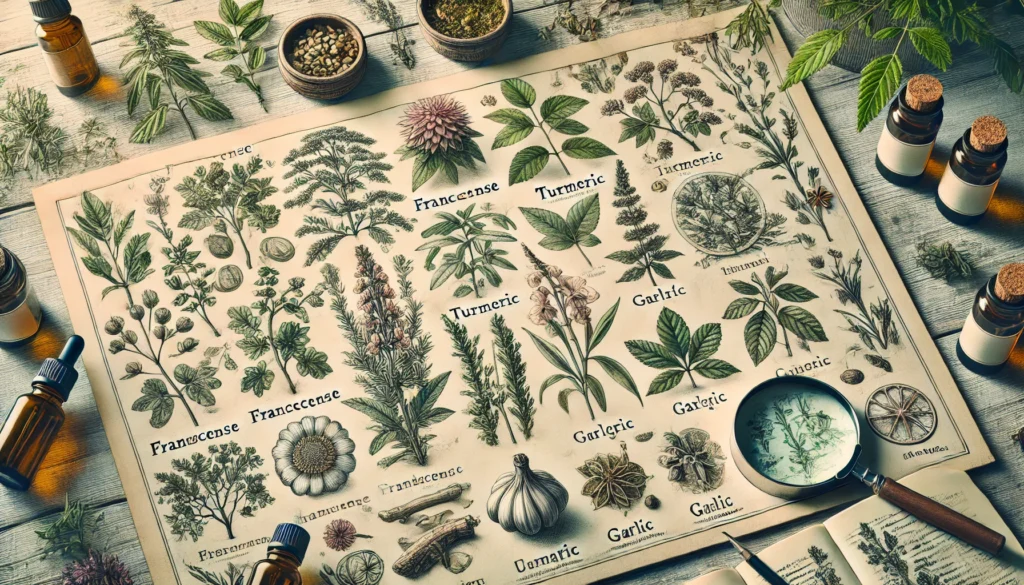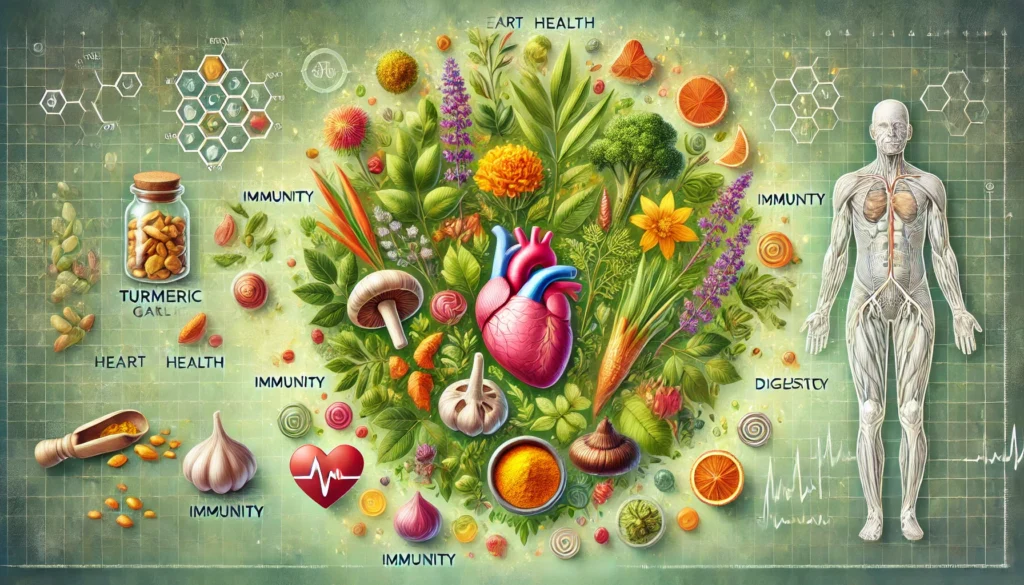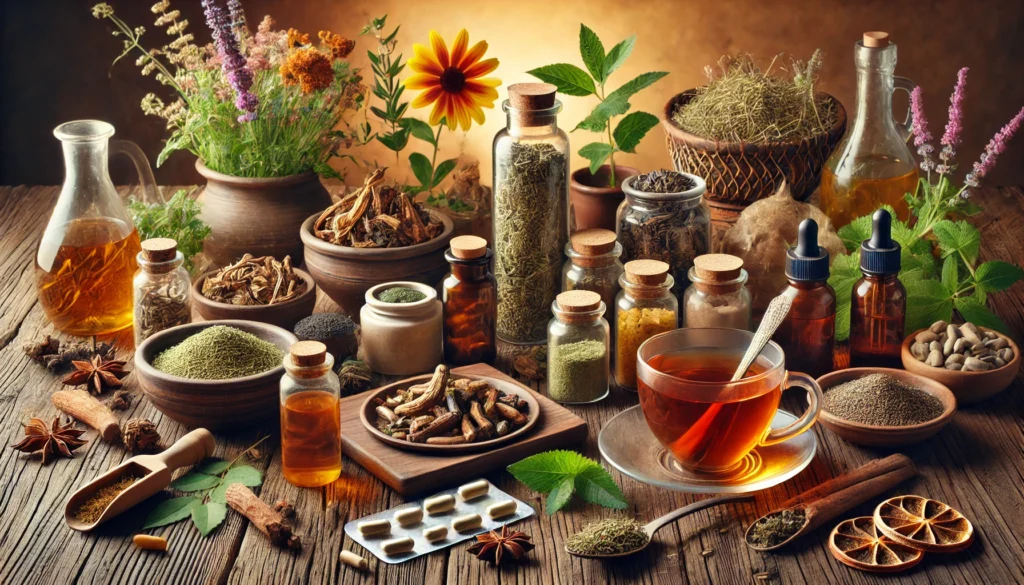Table of Contents
Turmeric Root: The Golden Spice with Powerful Health Benefits
Turmeric root has earned its reputation as one of the most powerful natural remedies in the world, revered for its health-promoting properties for over 4,000 years. This golden spice, known for its vibrant color and earthy flavor, has been used for everything from medicinal applications to religious rituals. But it’s not just ancient civilizations that praised turmeric—modern research confirms its numerous health benefits, largely due to its potent antioxidant and anti-inflammatory properties. In this blog, we’ll dive into the history, nutritional profile, health benefits, and the best ways to incorporate turmeric into your daily life.
This site contains affiliate links, and I may receive a commission on purchases made through them. Please see our Affiliate Disclosure for more details.

Historical Significance
Ancient Use
Turmeric’s story begins in the lush, tropical regions of India, where it has been cultivated and used for thousands of years. The use of turmeric root in traditional Indian medicine, also known as Ayurveda, dates back to around 2500 BCE. Ayurvedic healers used turmeric to treat a wide variety of ailments, including digestive issues, respiratory problems, and skin conditions. In Ayurvedic texts, turmeric is referred to as Haridra, a powerful herb that balances the body’s energy.
Traditional Chinese medicine also embraced turmeric, using it as a treatment for pain and inflammation, particularly in the case of arthritis and joint disorders. Over time, turmeric became a staple in the traditional medicinal systems of many Asian countries, valued for its ability to heal both externally and internally.
Cultural Importance
Turmeric’s significance extends far beyond medicine. In India, turmeric is deeply ingrained in religious and cultural traditions. It is used in Hindu ceremonies, especially in weddings, where turmeric is believed to bring good luck and prosperity. Brides and grooms often apply a paste of turmeric to their skin as part of a purification ritual, known as the haldi ceremony, which symbolizes blessing, cleansing, and radiance.
In addition to its cultural and medicinal significance, turmeric has long been a cornerstone of Indian cuisine. It’s the spice that gives curry its distinctive yellow color and earthy flavor, and it has been cherished in Middle Eastern and Southeast Asian cuisines for centuries.
Global Spread
The fame of turmeric spread far beyond India through ancient trade routes. Arab traders brought turmeric to the Middle East, Africa, and eventually to Europe. By the 18th century, turmeric was known in Europe as “Indian saffron,” due to its vibrant color and relative affordability compared to actual saffron. Today, turmeric is recognized worldwide for its versatility in food, cosmetics, and health products.

Botanical Profile
Plant Overview
Turmeric comes from the root of the Curcuma longa plant, a member of the ginger family. The turmeric plant grows up to three feet tall and has large, broad leaves and cone-shaped flowers. The real treasure lies beneath the soil—the bright orange-yellow rhizomes that are harvested for their culinary and medicinal uses.
The turmeric root is tough and fibrous on the outside, with a golden, earthy interior. Its distinct color comes from curcumin, the active compound responsible for many of turmeric’s health benefits.
Growing Conditions
Turmeric thrives in warm, tropical climates with plenty of rain, making India the largest producer of this spice. It is typically grown in regions with well-drained, fertile soil, and is harvested once the leaves of the plant begin to dry out. Farmers then dig up the turmeric rhizomes, boil them, dry them, and grind them into the powder that’s commonly used around the world.
Different Varieties
There are several varieties of turmeric, but the two most well-known types are:
- Alleppey turmeric: Known for its deep orange color and high curcumin content, this variety is often preferred for medicinal purposes due to its potency.
- Madras turmeric: A lighter yellow variety commonly used in culinary applications, especially in powdered form for its mild flavor.
Both varieties have powerful health benefits, but Alleppey turmeric is often the go-to choice for those seeking the highest curcumin levels.

Nutritional and Phytochemical Profile
Nutritional Content
Turmeric is not only a flavorful addition to dishes but also packs an impressive nutritional punch. A tablespoon of turmeric contains:
- Fiber: Helps regulate digestion and supports gut health.
- Vitamins: Rich in vitamin C, which boosts immunity and skin health, and contains small amounts of vitamin B6, important for brain health.
- Minerals: Provides iron, which supports red blood cell production, as well as manganese and potassium, both essential for various body functions.
Phytochemicals
Turmeric’s most significant contribution to health is its wealth of phytochemicals, particularly curcumin. Curcumin is responsible for turmeric’s vibrant color and most of its health-promoting properties, including its powerful anti-inflammatory and antioxidant effects.
Other Active Compounds
In addition to curcumin, turmeric contains several other bioactive compounds, such as:
- Turmerone: A compound found in turmeric oil that has shown promise in supporting brain health.
- Zingiberene: A natural compound that gives turmeric some of its anti-inflammatory properties, similar to its relative, ginger.
- Polysaccharides: These contribute to turmeric’s immune-boosting and anti-inflammatory effects.

Health Benefits of Turmeric Root
The potential health benefits of turmeric are wide-ranging, and much of it is thanks to curcumin, its star compound. Here are some of the most impressive ways turmeric can support your health.
Anti-inflammatory and Pain Relief
One of turmeric’s most well-documented benefits is its ability to reduce inflammation. Chronic inflammation is linked to a variety of diseases, including heart disease, cancer, and Alzheimer’s. Curcumin has been shown to block molecules in the body that cause inflammation, providing natural relief for those suffering from arthritis, joint pain, and other inflammatory conditions.
Studies have found that curcumin can be as effective as some over-the-counter anti-inflammatory drugs, without the harmful side effects.
Antioxidant Power
Turmeric is a potent antioxidant that helps neutralize harmful free radicals in the body, which can damage cells and accelerate aging. By reducing oxidative stress, turmeric helps prevent chronic diseases such as heart disease, diabetes, and even cancer. Its antioxidant properties also support overall health and longevity.
Immune System Boost
Turmeric strengthens the immune system by boosting the body’s ability to fight off pathogens. Its anti-inflammatory and antimicrobial properties make it an excellent choice for those looking to enhance their immune response naturally.
Digestive Health
Turmeric has been used for centuries to treat digestive issues such as bloating, gas, and indigestion. Curcumin stimulates bile production in the liver, which helps improve digestion and prevent gastrointestinal issues. Its anti-inflammatory effects also make it helpful for those suffering from inflammatory bowel diseases like Crohn’s disease and ulcerative colitis.
Heart Health
Turmeric’s anti-inflammatory properties also extend to heart health. It helps improve the function of the endothelium, the lining of blood vessels, which plays a crucial role in regulating blood pressure and preventing blood clots. Studies have shown that turmeric can help reduce cholesterol levels, improve circulation, and prevent plaque buildup in arteries, lowering the risk of heart disease.
Brain Health and Cognitive Function
Curcumin has shown promise in supporting brain health and improving cognitive function. It helps increase levels of brain-derived neurotrophic factor (BDNF), a growth hormone that supports the growth of new neurons and protects against age-related cognitive decline. Research suggests that curcumin may help reduce the risk of neurodegenerative diseases like Alzheimer’s and Parkinson’s.
Cancer Prevention
Numerous studies have examined curcumin’s role in cancer prevention. Research shows that curcumin may help inhibit the growth of cancer cells, reduce the spread of tumors, and even make cancer cells more susceptible to treatment. Its antioxidant and anti-inflammatory properties are key factors in its ability to protect cells from mutations that can lead to cancer.
Skin Health
Turmeric has long been used to promote healthy, glowing skin. Its anti-inflammatory and antimicrobial properties make it effective in treating acne, reducing redness, and calming inflammatory skin conditions like eczema and psoriasis. Turmeric can also help brighten the skin and reduce dark spots, making it a popular ingredient in skincare products.
Blood Sugar Regulation
For people with diabetes or those at risk, turmeric may be an important tool in regulating blood sugar levels. Research shows that curcumin improves insulin sensitivity and reduces blood sugar spikes, helping to manage type 2 diabetes and prevent related complications.
Liver Detoxification
Turmeric is known for its ability to support liver health by stimulating bile production and enhancing the body’s natural detoxification processes. This makes it useful for promoting liver function, particularly in individuals exposed to toxins or alcohol.

Methods of Consumption
There are many ways to incorporate turmeric into your diet and daily routine. Each method offers unique benefits and levels of curcumin absorption.
Fresh Turmeric Root
Using fresh turmeric root is one of the most potent ways to benefit from its active compounds. The fresh root can be grated or sliced and added to smoothies, teas, soups, or curries. It has a more intense flavor than powdered turmeric and retains higher concentrations of curcumin.
Turmeric Powder
Turmeric powder is the most common and convenient form of turmeric, often used in cooking. It’s perfect for seasoning dishes, making golden milk, or adding to smoothies. To boost curcumin absorption, pair turmeric with black pepper, which contains piperine, a compound that increases curcumin’s bioavailability by up to 2,000%.
Turmeric Supplements
For those who want a concentrated dose of turmeric, supplements offer a convenient option. Turmeric supplements typically contain standardized curcumin extracts and are often paired with piperine for enhanced absorption. These are ideal for those seeking the anti-inflammatory and antioxidant benefits of turmeric in a convenient capsule form.
Turmeric Tea
Turmeric tea is a soothing way to enjoy the benefits of this spice. You can make it by boiling fresh turmeric root or using powdered turmeric in hot water. Adding ginger, honey, or black pepper can enhance its flavor and boost its health benefits.
Turmeric Tinctures
Tinctures are concentrated liquid forms of turmeric that are fast-acting and easy to take. A few drops can be added to water, tea, or taken directly under the tongue for a quick dose of curcumin.
Topical Use
Turmeric is a popular ingredient in skincare products, thanks to its anti-inflammatory and brightening properties. You can also make a turmeric paste by mixing turmeric powder with water or oil to apply directly to the skin. This is often used to treat acne, reduce redness, and improve overall skin tone.

Cautionary Advice
While turmeric is safe for most people, there are a few precautions to keep in mind.
Potential Side Effects
When consumed in large quantities, turmeric may cause digestive upset, including nausea or diarrhea. It’s best to start with smaller amounts and gradually increase your intake.
Medication Interactions
Turmeric can interact with certain medications, particularly blood thinners like warfarin, aspirin, and clopidogrel, due to its natural blood-thinning properties. It may also interfere with medications for diabetes or acid reflux. Always consult your healthcare provider before adding high doses of turmeric or curcumin supplements to your routine if you are on any medication.
Allergies
While rare, some people may experience allergic reactions to turmeric, particularly when applied to the skin. Symptoms may include itching, redness, or swelling. Always do a patch test before applying turmeric topically.
Safe Dosage
The recommended dosage of curcumin for most people ranges from 500 to 2,000 mg per day, depending on the form and individual health needs. When using supplements, it’s important to choose one with bioavailability enhancers like piperine to ensure you’re absorbing enough curcumin.
Pregnancy and Nursing
Pregnant and breastfeeding women should use caution when consuming large amounts of turmeric, as it may stimulate uterine contractions. While small amounts of turmeric in food are generally considered safe, it’s best to avoid high doses of supplements during pregnancy unless advised by a healthcare provider.

Conclusion
Turmeric root is far more than just a colorful spice—it’s a potent natural remedy with a range of health benefits backed by centuries of use and modern scientific research. From reducing inflammation and boosting heart health to supporting brain function and improving skin, turmeric has something to offer everyone.
Whether you choose to add fresh turmeric root to your recipes, enjoy a cup of turmeric tea, or take it in supplement form, incorporating turmeric into your daily routine is a simple and effective way to support long-term health and wellness. Explore the different forms of turmeric, and let this golden spice brighten both your meals and your health.
